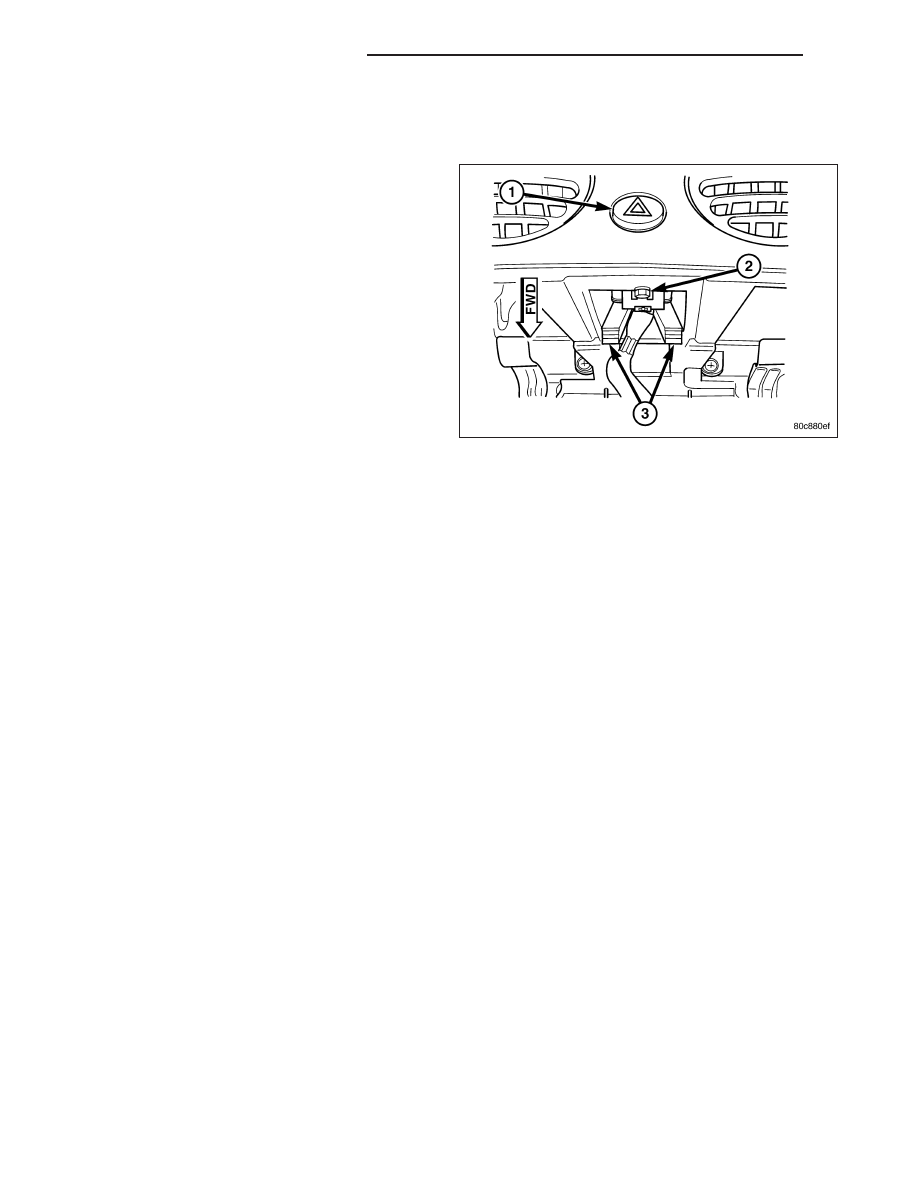Jeep Liberty KJ. Manual - part 102

HAZARD SWITCH
DESCRIPTION
The hazard switch is integral to the hazard switch
module, which is secured near the center of instru-
ment panel just above the radio. Only the hazard
switch button (1) is visible through a dedicated, bev-
eled, circular opening in the instrument panel between
the two center panel outlets of the heat and air condi-
tioning system. A red, stencil-like International Control
and Display Symbol icon for “Hazard Warning” identi-
fies the hazard switch button. The remainder of the
hazard switch module is concealed behind the instru-
ment panel.
All of the circuitry and components of the hazard switch module are contained within a molded black plastic hous-
ing. On the opposite end of the housing from the switch button is an integral connector receptacle and a stamped
steel mounting bracket. The mounting bracket includes two latch feature tabs (3) that extend downward to support
the back of the housing. These tabs engage the edge of the mounting hole provided for the switch in the instrument
panel above the radio opening. The switch module housing also has an integral short, dowel-like alignment pin on
each side just behind the switch button that is engaged in integral ramp formations in the instrument panel two align
and support the face of the module. Finally, a single screw (2) through the top of the radio opening securely fastens
the switch module to the instrument panel.
The switch module is connected to the vehicle electrical system through a single dedicated take out and connector
of the instrument panel wire harness. Within the hazard switch module is the hazard switch circuitry, which includes
a circuit board with both the hazard switch and the electronic combination flasher circuitry. The circuitry of the com-
bination flasher performs both the hazard flasher and the turn signal flasher functions.
The hazard switch module cannot be adjusted or repaired and, if inoperative or damaged, it must be replaced as a
unit.
OPERATION
The hazard switch button is slightly recessed in the instrument panel when the switch is in the Off position, and
latches at a position that is flush with the outer surface of the instrument panel when in the On position. The hazard
switch module circuit board includes miniature relays that produce audible clicking to emulate the sound of a con-
ventional flasher whenever the turn signals or the hazard warning system are activated.
The hazard switch module receives battery voltage on a fused B(+) circuit from a fuse in the Junction Block (JB) at
all times for operation of the hazard warning, and on a fused ignition switch output (run) circuit from another fuse in
the JB whenever the ignition switch is in the On position for operation of the turn signals. The module receives a
path to ground through a splice block secured by a nut to a ground stud on the driver side instrument panel end
bracket near the JB.
Inputs to and outputs from the hazard switch module include:
•
Panel Lamps Dimmer Input - A non-serviceable incandescent bulb soldered onto the hazard switch module
provides illumination of the switch button when the exterior lighting is turned On through the fused panel lamps
dimmer switch signal circuit. This bulb flashes on and off at full intensity whenever the hazard switch button is
activated, regardless of the status of the exterior lighting.
•
Hazard Switch Input - The combination flasher receives an internal ground input from the hazard switch to
request hazard flasher operation.
•
Multi-Function Switch Input - The combination flasher receives separate ground inputs from the multi-func-
tion switch on right and left turn switch sense circuits to request turn signal flasher operation.
•
Body Control Module Input - The Body Control Module (BCM) can request hazard flasher operation by pro-
viding a ground path to the combination flasher through a hazard lamp control circuit.
8L - 66
LAMPS/LIGHTING - EXTERIOR
KJ